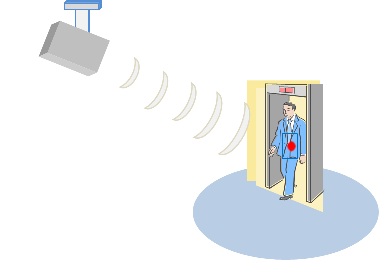Surveillance Application System
KSK Corporation
1-14-4, Kyobashi, Chuo-ku,Tokyo,Japan
Security check (virtual pat-down search)
Product outline
10 years after the terrorist attacks in the United States in 2001, the
constant occurrence of terrorism continues to be a major social problem
around the world.
Since the attacks, Japan has been identified as a target for terrorism by Islamic extremists. As we, like other countries around the world, face the threat of international terrorism, we should be vigilant and take thorough countermeasures against such terrorism.
In addition, prohibited imports such as drugs and handguns continue to grow as a social problem. An early solution is also needed for the important task of stopping smuggling at the border.
Against this background, domestic airports are trying to strengthen the security of immigration checks, including X-ray inspection of boarding passengers' shoes and pat-down search (security check) by contact with inspectors. However, there is also the opinion that boarding passengers may feel uncomfortable being touched by inspectors, and it will be difficult to make them understand.
Our "Terahertz Wave Compact Body Scanning System" can reduce the stress of boarding passengers by providing a non-contact, privacy-conscious, image-based inspection method.
In addition, the addition of an automatic alarm function simplifies operation. This can also reduce the workload of inspectors.
This system can detect metals as well as a wide variety of non-metals such as plastics, ceramics, liquids, powders, tablets, etc. that cannot be detected by metal detectors.
By the way, it seems that many people have some preconceptions that body scanners generally violate their privacy, such as "the whole body can be seen through" or "it results in people being completely undressed in a virtual world". Another preconception is that it affects a health aspect, such as "being exposed to radiation".
For permeability, the electromagnetic waves used in this system are terahertz waves, which have far less energy than X-rays, so there is no need to worry about the inside of the body being displayed on the monitor.
These images are well processed so that the contours of the underwear and body cannot be identified.
As for radiation exposure, instead of the active system, where the person is irradiated by the inspection equipment, the passive system is used, where the inspection equipment passively receives the electromagnetic waves emitted by people and objects. Therefore, there is no possible danger of radiation exposure.
The size of the inspection device is compact and lightweight, so one of its attractions is that it can be installed anywhere. In addition to airports, it can be installed at the entrances and exits of facilities such as ports, government offices, power plants, embassies, and event venues to protect large numbers of people from indiscriminate terrorism.
It can also be used to prevent smuggling at airports and ports, theft in warehouses and factories, and information leakage in offices and data centers.

Since the attacks, Japan has been identified as a target for terrorism by Islamic extremists. As we, like other countries around the world, face the threat of international terrorism, we should be vigilant and take thorough countermeasures against such terrorism.
In addition, prohibited imports such as drugs and handguns continue to grow as a social problem. An early solution is also needed for the important task of stopping smuggling at the border.
Against this background, domestic airports are trying to strengthen the security of immigration checks, including X-ray inspection of boarding passengers' shoes and pat-down search (security check) by contact with inspectors. However, there is also the opinion that boarding passengers may feel uncomfortable being touched by inspectors, and it will be difficult to make them understand.
Our "Terahertz Wave Compact Body Scanning System" can reduce the stress of boarding passengers by providing a non-contact, privacy-conscious, image-based inspection method.
In addition, the addition of an automatic alarm function simplifies operation. This can also reduce the workload of inspectors.
This system can detect metals as well as a wide variety of non-metals such as plastics, ceramics, liquids, powders, tablets, etc. that cannot be detected by metal detectors.
By the way, it seems that many people have some preconceptions that body scanners generally violate their privacy, such as "the whole body can be seen through" or "it results in people being completely undressed in a virtual world". Another preconception is that it affects a health aspect, such as "being exposed to radiation".
For permeability, the electromagnetic waves used in this system are terahertz waves, which have far less energy than X-rays, so there is no need to worry about the inside of the body being displayed on the monitor.
These images are well processed so that the contours of the underwear and body cannot be identified.
As for radiation exposure, instead of the active system, where the person is irradiated by the inspection equipment, the passive system is used, where the inspection equipment passively receives the electromagnetic waves emitted by people and objects. Therefore, there is no possible danger of radiation exposure.
The size of the inspection device is compact and lightweight, so one of its attractions is that it can be installed anywhere. In addition to airports, it can be installed at the entrances and exits of facilities such as ports, government offices, power plants, embassies, and event venues to protect large numbers of people from indiscriminate terrorism.
It can also be used to prevent smuggling at airports and ports, theft in warehouses and factories, and information leakage in offices and data centers.
■Application example: Where the device is suspended from the ceiling when in use.

バナースペース
KSK Corporation
Kyobashi
TS Bldg 9F, 1-14-4,
Kyobashi, Chuo-ku, Tokyo,
104-0031, Japan
TEL +81-3-3538-2331
FAX +81-3-3535-5510
access map